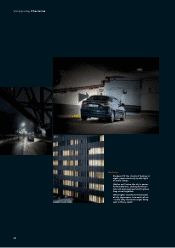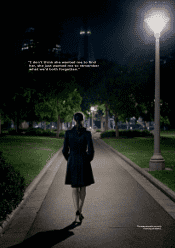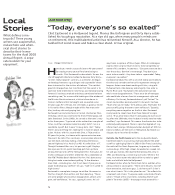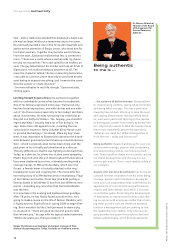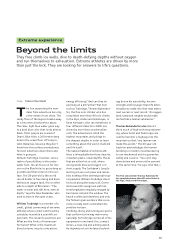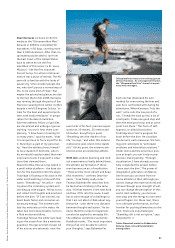Audi 2008 Annual Report Download - page 77
Download and view the complete annual report
Please find page 77 of the 2008 Audi annual report below. You can navigate through the pages in the report by either clicking on the pages listed below, or by using the keyword search tool below to find specific information within the annual report.
74
“Today, everyone’s so exalted”
Clint Eastwood is a Hollywood legend. Movies like Unforgiven and Dirty Harry estab-
lished his tough-guy reputation. At a ripe old age, when many people’s minds are
on retirement, this multitalented artist has reinvented himself. As a director, he has
tackled hot social issues and taken a clear stand. A true original.
What defines a me-
tropolis? Three young
writers use suspenseful,
melancholic and whim-
sical short stories to
describe their home-
towns for the Audi 2008
Annual Report. A sepa-
rate booklet for your
enjoyment.
Local
Stories
A
A
u
u
t
t
h
h
e
e
n
n
t
t
i
i
c
c
i
i
t
t
y
y
ways been suspicious of those types. When his colleagues
express their surprise that he seems to be completely un-
aware of his stardom, he counters: “Everyone wants to be a
star these days. But that’s not enough. They don’t just
want to be a model – they have to be a supermodel. Today,
everyone’s so exalted.”
Eastwood combats this with a sense of reality and modesty
that has only served to enhance his reputation among col-
leagues. Actors rave about working with him, using old-
fashioned terms like decency and integrity. One actor in
Mystic River said: “Eastwood is the only American icon
who’s not a disappointment.” There are a lot of managers
who could take a lesson from his management style and
efficiency. On the set, Eastwood doesn’t yell “Action!” In-
stead, he describes precisely what it is he wants to show.
“Start when you’re ready,” he’ll add casually. That takes the
pressure off, giving the actors room to flourish. Typically,
everything comes together on the first take: Eastwood
rarely needs to shoot more than three takes of a single
scene. “If an actor knows that it’s only going to start count-
ing after the 19th take, then he doesn’t really need to make
an effort,” says Eastwood. This means the director has to be
extremely well prepared. There is a positive byproduct: sig-
nificant cost-savings. While production budgets of 100 mil-
lion U.S. dollars are the norm in Hollywood, Eastwood usu-
ally gets by on less than 30 million.
Outside, the Pacific breaks onto the sandy white beach.
Could Eastwood’s unassuming style possibly be the prod-
uct of his upbringing? Born in 1930 in San Francisco during
the midst of the Great Depression, he grew up in humble
surroundings. After high school, he worked as a wood cut-
ter and gas station attendant before joining the army in
1951 and becoming a swimming instructor. While in the
army, he met an actor who advised him to take his good
looks and athletic build to Hollywood.
Eastwood smiles when he thinks back to his audition at an
acting school in Los Angeles. “There were 40 girls, most of
them attractive, and seven guys. I said to myself: ‘I don’t
care what it costs. This is the place for me.’” He reflects for
a moment and smiles. “Everyone needs some kind of moti-
vation.” He got a few small roles, including that of a jet
pilot in Tarantula (1955) – the oxygen mask covered his
ow do you remain successful over a 40-year career?
By staying true to yourself and continuing to
stretch. Clint Eastwood has done both. He was the
star of Spaghetti Westerns before he became Dirty Harry –
“a role I really enjoyed.” Later on, as a director, he began
to develop characters a gunslinger and cop wouldn’t have
been interested in: the victims of violence. “I’m not that
good at introspection, but I do think that the secret is to
continue to be interested in new things and to keep moving
forward. I’ve always worked and always continued to learn
something new,” he muses while looking out the window of
the Mission Ranch restaurant, a historic farmhouse in
Carmel, California that he bought and renovated some
20 years ago. He’s 78 now, but still looks as good as he did
in his earlier films; though maybe with a few more wrin-
kles; leathery skin and graying hair.
Eastwood lives and entertains in Carmel situated on Mon-
terey Bay, which was once home to Ernest Hemingway and
John Steinbeck. In the 1980s, he served as the town’s may-
or for three years: “I got mad at the authorities a couple of
times, and then someone asked me why I didn’t run as a
candidate myself. But it wasn’t a long-term stint.” Today,
there’s only one thing he’s looking for in Carmel: peace and
quiet. He lives with his second wife Dina, a TV journalist
35 years his junior, in a house with a panoramic view over
the coast. He calls it his sanctuary; a scenic place where he
can kick back and enjoy taking a ride along the famous
coastal highway in his Audi Q7 or A8. His wife drives a TT.
Though Eastwood likes cars, his passion is golf. He plays
like a pro and his 11-point handicap puts him up there
among the top ranks of the Hollywood elite. Every year, he
invites colleagues and other celebrities for a showdown at
the AT&T Pebble Beach National Pro-Am. He’s done every-
thing but make a movie about golfing. “A few directors
have tried – including me – but it just doesn’t give you an
angle to develop any conflict,” he says. “Golf isn’t suited to
high drama.”
Eastwood is a complete stranger to artifice. He seems to
find his strength from within, not from boasting. “There
are some people who exude an exaggerated, almost arro-
gant self-confidence,” he says, sipping his wine. He’s al-
H
Copy Holger Christmann



